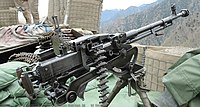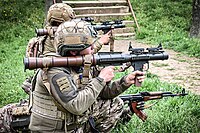| Zacapine Army |
|---|
|
| Active | Since 1904; 120 years ago (1904) |
|---|
| Country |  Zacapican Zacapican |
|---|
| Type | Army |
|---|
| Role | Land warfare |
|---|
| Size | - 50,000 in peacetime
∟ 3,400 peacetime staff
∟ 600 civlians
∟ 16,000 active Republican Guards
∟ 15,000 Conscripts
∟ 15,000 reservists in refresher training
250,000 in wartime
|
|---|
| Part of | Zacapine Armed Forces |
|---|
|
| Commander-in-Chief | Zianya Xcaret |
|---|
| Secretary of Defense | Chicacua Xiomara |
|---|
| Chief of the General Staff | Nezahualcoyotl Amanaztli |
|---|
| Army Chief of Staff | Hladimi Qalchic |
|---|
The Zacapine Army (Nahuatl: 𐐏𐐰𐐬𐐿𐐨𐑆𐐿𐐯 𐐞𐐰𐐿𐐰𐐹𐐨𐐷𐐬𐐻𐑊, Yaoquizque Zacapiyotl) is the consolidated land warfare component of the Zacapine Armed Forces, encompassing the professional contractors, conscripted forces and Guard forces of each Zacapine constituent republic. The Army has a relatively small peacetime force of 50,000, the majority of which are conscripts completing an initial tour of duty or reservists recalled for a period of refresher training. In case of war, the Zacapine Army is organized to quickly mobilize its large reservist components to reach a total of 250,000 service members under wartime mobilization conditions. This reservist heavy structure of the Army is a consequence of the Zacapine military doctrine of Navy primacy which establishes the Naval formations as the primary offensive arm of the military and designates the Army as a defensive force. The large numbers of servicemembers at the disposal of the Zacapine Army's mobilization system are intended to deter and repulse any invasion of the Zacapine homeland by a hostile power, having little to no capability for a rapid offensive campaign or invasion of their own.
Role
The principal military planners and thinkers in the Zacapine hierarchy generally do not consider Zacapican to be under serious threat of an imminent invasion by its neighbors. This view is supported by the experiences of past wars in Oxidentale which have shown the mountainous and arid regions of the continent's interior in general and the border zone of northern Zacapican in particular to be generally hostile to the conduct of large scale military operations, making a full scale enemy invasion over this border an unlikely event. However, this same consideration has meant that any army of the Zacapines will likewise have great difficulty carrying out an offensive campaign against any of its neighbors over land. Consequently, the Zacapine Army has settled into the role of supporting a potential amphibious offensive by augmenting the manpower of any Naval Infantry detachment, deterring a hostile amphibious attack through their numbers and presence at or near the vital port cities of Zacapican, as well as preparing for any localized border war or skirmish that may occur on the border. Since the time of the Zacapine Revolution, much of the Army's manpower has been occupied primarily with internal security in the form of the Rural National Guard, the precursor to today's Republican Guards, leaving the conventional warfare capabilities of the Army a secondary consideration.
Following a series of reforms in the 1960s accompanied by a general modernization initiative across all of the Armed Forces, the Zacapine Army was overhauled and much of its active professional force was disbanded in favor of the reservist system it uses today. Because of the reduced role of the Army in the Zacapine military, the maintenance of a large fully staffed professional force in peacetime was considered to be a gross misallocation of valuable resources. However, Zacapine military officials did not want to drastically reduce the size of the Army in case war should emerge. The primary concearn was that an Army cut down to a minimum size would not be able to provide auxiliary manpower to an expeditionary deployment of the Naval Infantry in an intervention elsewhere in the world. The possibility of a direct invasion of the Zacapine homeland by a hostile power was considered a relatively remote possibility due to the perceived power of the Zacapine Navy which would protect the homeland in such a scenario, but the great threat such an attack would bring to a country whose population and industry is concentrated along the coasts could not be entirely ignored. The result was the reservist system, in which a small professional force made up almost entirely of a training establishment and civilian maintenance personnel would perpetually train and exercise a body of conscripts and reservists such that in case of war, the Zacapine Army would be able to mobilize a large body of relatively well trained and prepared reservist forces in short order with minimal refresher training required. This would greatly reduce the sustainment costs of the Army during peacetime while satisfying the military's desire to maintain a sizable deterrent to invasion and a reserve of manpower to draw upon for other operations.
Organization
The Zacapine Army is organized into 6 regular brigades and 4 Guards brigades for a total peacetime strength of 10 brigades. Each regular brigade, consisting of reservists and first tour conscripts, numbers 5,000 men while the Guards brigades consist of roughly 4,000 men. As the Guards units represent the active components of each of the 9 constituent Republics paramilitary forces, they are generally divided into Regimental units pertaining of each of the nine Republics which are then trained and exercised together both for the readiness of the troops as well as the valuable practice in coordinating the different Guards forces together under the Army command structure.
Equipment
Infantry Equipment
Pistols
Submachine Guns
| Model
|
Origin
|
Type
|
Image
|
Details
|
| ZAC-10 |
 Zacapican Zacapican |
Machine pistol/submachine gun |
 |
Compact submachine gun/machine pistol, standard issue among vehicle crews due to its small size. Chambered in .45 automatic.
|
| Cuauhtli O57 |
 Zacapican Zacapican |
Submachine gun |
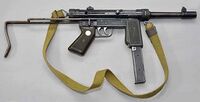 |
Produced in large numbers and retained in stockpiles, standard submachine gun for reserve units and security forces. Chambered in .45 automatic.
|
Semi-automatic and Bolt-action Rifles
| Model
|
Origin
|
Type
|
Image
|
Details
|
| TQ-59 |
 Zacapican Zacapican |
Battle rifle |
 |
Chambered in 7.62x51mm. Served as the main service rifle of the Zacapine military between 1930 and 1960, remains in service as a designated marksman rifle and as a weapon for low readiness reservist and Republican Guard units.
|
| O24 Rifle |
 Zacapican Zacapican |
Sniper rifle |
 |
Standard issue sniper rifle of the Zacapine military, chambered in 7.26x51mm.
|
Assault Rifles
Machine Guns
Missile Systems
Infantry Support Vehicles
| Model
|
Origin
|
Type
|
Image
|
Details
|
| ZTATZ |
 Zacapican Zacapican |
Infantry fighting vehicle |
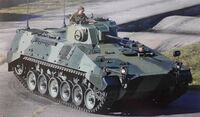 |
IFV based on the ZTA Light Tank chassis, mainstay armored vehicle of the Zacapine army armored forces.
|
| ZMCT |
 Zacapican Zacapican |
Infantry fighting vehicle |
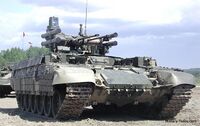 |
IFV based on the O74 chassis and the older YCT Nagual variant, modified with a new turret and passenger compartment in the hull.
|
Tanks
| Model
|
Origin
|
Type
|
Image
|
Details
|
| O17 |
 Zacapican Zacapican |
Main battle tank |
 |
Most advanced Zacapine tank model, in limited use with the Zacapine Army for training purposes. Primarily in service with the Naval Infantry and temporarily loaned to the Army to familiarize Army operators with the vehicle.
|
| O74 |
 Zacapican Zacapican |
Main battle tank |
 |
Mainstay of the Zacapine armored fleet, produced in large numbers and exported to key allied militaries. O74 YN and O74 YNA modernized varients form most of the active tank units, while older O74 Y and basic O74 models remain in reserve.
|
| ZTA Light Tank |
 Zacapican Zacapican |
Light tank |
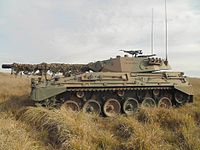 |
Light tank in service with the Zacapine Army, exceeding the force of MBTs in number produced and in Army stockpiles. Tank-destroyer variant also common in Army service.
|
Towed Artillery and Mortars
Self-Propelled Artillery
| Model
|
Origin
|
Type
|
Image
|
Details
|
| AM-2 |
 Zacapican Zacapican |
Self-propelled artillery |
 |
Wheeled self-propelled 155mm howitzer, most common of the Zacapine Army self-propelled artillery pieces due to low production and maintenance costs.
|
| O74 HT |
 Zacapican Zacapican |
Self-propelled artillery |
 |
Self-propelled gun variant of O74 tank, armed with powerful 155mm howitzer.
|
| ZTA-PT |
 Zacapican Zacapican |
Self-propelled artillery |
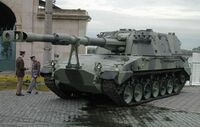 |
Self-propelled gun variant of the ZTA light tank. Lighter and cheaper vehicle than the O74 HT, armed with the same 155mm howitzer.
|
| O74 Tzitztimitl |
 Zacapican Zacapican |
Multiple rocket launcher |
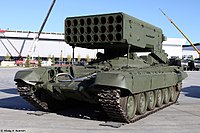 |
Heavy self-propelled MRL system based on the O74 chassis, capable of firing 220mm conventional and thermobaric rockets.
|
| ZTA-MT |
 Zacapican Zacapican |
Multiple rocket launcher |
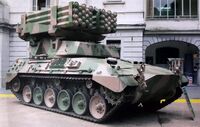 |
Light self-propelled MRL system built on the ZTA Light Tank chassis. Armed with 160mm rocket tubes, capable of modification to launch 220mm rockets including thermobarics used by the O74 Tzitzimitl.
|









